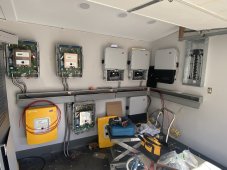NorthTown2022
New Member
Looking for advice on type of material to mount solar inverter and mppt's etc.
The interior of my shed is sheeted with 7/16 OSB which likely does not offer much support for.mounting heavy equipment.
I would like to mount to a non flamable material such as cement board or perhaps 1/8" aluminum checker plate but both seem to have thier own draw backs. I would imagine for either i would need to use a 3/4" plywood backer for a bit of integrity.
Wondering what others have used?
The interior of my shed is sheeted with 7/16 OSB which likely does not offer much support for.mounting heavy equipment.
I would like to mount to a non flamable material such as cement board or perhaps 1/8" aluminum checker plate but both seem to have thier own draw backs. I would imagine for either i would need to use a 3/4" plywood backer for a bit of integrity.
Wondering what others have used?




